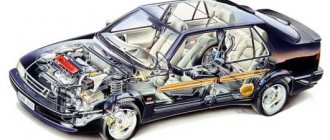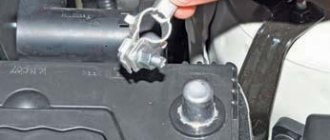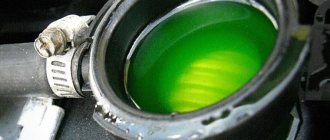What is a catalyst and how does it work?
Exhaust gases are waste products from engine operation.
It consists of many toxic chemical compounds that cause serious damage to human health and nature. A catalyst is a device that levels their concentration to a minimum value. It is built into the car's exhaust system between the engine and the muffler.
The catalyst consists of three main parts:
- Filter element or media . It consists of honeycomb cells in which, at high temperatures, neutralization (combustion) of harmful gases and fuel residues occurs.
- Thermal insulator . Necessary to maintain the required temperature inside the device.
- Metal casing with ventilation perforation . Protects the product from inadvertent contact with a hot device.
The operation of the catalyst is monitored by sensors. The first of them is located before the neutralizer. It records information about the amount of unburned fuel in the exhaust gases. Another sensor monitors the quality of exhaust gases at the outlet of the catalyst. Information from the sensors is transmitted to the engine ECU, which regulates the fuel supply.
Over time, the honeycomb structure of the catalyst becomes clogged and the device ceases to fulfill its purpose. Next we will look at the main signs of a clogged catalyst.
How to determine the malfunction?
What are the signs of a clogged catalyst? There are several symptoms that can help you identify a malfunction of this element:
- The car became difficult to start.
- Dips appear during movement, which sometimes disappear.
- The "Check Engine" light is on.
The reasons for the poor acceleration dynamics are explained by the low throughput of the catalyst.
Sometimes it happens that a car easily picks up a speed of 150 km/h and then, stopping, barely accelerates to 60. As a result, engine performance decreases sharply (low level of cylinder ventilation). The engine is not able to capture a new portion of air, since the exhaust gases cannot exit the system normally - they “get stuck” in the combustion chamber.
Signs of a clogged catalyst
Signs of a clogged catalyst are hard to miss. Typically this malfunction manifests itself as follows:
- The engine loses power and gains speed with difficulty.
- Fuel consumption increases.
- The “Check Engine” error message appears on the dashboard.
- Problems arise when starting the engine.
If there are signs of a clogged catalyst, it needs to be checked. To do this, you can place your hand or paper against the muffler outlet. The exhaust gases must be noticeable and pulsed.
Another way to check is based on how the engine revs. With the engine running and the gearbox in neutral, press the accelerator pedal to the floor. If the tachometer needle stops at 3,000 rpm and does not rise higher, this may indicate problems with the catalyst.
The most effective method is to install a pressure gauge instead of a sensor that goes in front of the catalyst. This way the pressure in the system is checked. It should correspond to a value of 0.3 kgf/cm 3. In this case, the tachometer should show 2,500 rpm. The disadvantage of this method is the complexity of its installation. The iron of the system is so welded that it is not so easy to separate their parts in the usual way.
A more acceptable option: instead of a spark plug, install a motor tester, which also shows the pressure level in the system.
The essence of the breakdown
The catalyst looks like a thick section of the exhaust system. A catalytic element coated with a special layer of platinum group metals is installed inside the housing. The element is made in the shape of a cylinder and has a honeycomb structure. A large number of honeycombs allows you to maximize the contact area of the exhaust gases with a special coating, thereby increasing the degree of exhaust oxidation.
It is the small diameter of the honeycombs that leads to them becoming clogged with deposits of low-quality gasoline and oil, reducing the flow area for exhaust gases. This is why it becomes more difficult for the car to “breathe”, since exhaust gases back up during the exhaust stroke. This, in turn, leads to poor purging of the chamber and incomplete combustion of the subsequent portion of fuel, which negatively affects consumption. In some cases, the honeycomb may melt, which leads to similar consequences.
We found out that there are only two options for catalyst failure:
- clogged catalyst when the honeycomb becomes clogged;
- wear of a special coating that reacts with exhaust gases.
Causes
The catalyst is capable of faithfully serving up to 150-200 thousand km. But in practice, it happens that many drivers have to find out about the breakdown of this system much earlier. The following reasons lead to accelerated failure:
- poor fuel quality;
- zhor oil, the combustion products of which will settle inside the honeycomb. Increased oil consumption may occur due to a faulty turbine;
- improper operation of the engine associated with adjustment of the ignition system, power supply and valve timing;
- mechanical damage to the element or sudden temperature changes. For example, a wave of ice water entering under the car when the catalyst is significantly heated by exhaust gases.
A single case of using bad fuel, as well as a sharply increased oil consumption, cannot cause failure of the catalytic converter. Only a long period of operation under conditions harmful to the catalyst can lead to breakdown and the appearance of an error on the dashboard.
Consequences
Many drivers ignore the signs of a clogged catalyst, considering this element only a “fighter” for the preservation of the environmental environment. There is no need to do the same under any circumstances. After all, the catalytic converter is a standard “diagnostician” of engine operation. Therefore, errors that appear on the catalyst can signal not only the failure of the element itself, but also a malfunction of the ignition system.
Why does the catalyst clog?
If we exclude cases of the car being involved in an accident or damage to the exhaust system as a result of the bottom hitting an obstacle, then there are three main reasons.
Poor fuel quality. When it burns, the temperature may be higher than permissible. The components of the main element, the carrier, melt and fail. Additives with iron particles added to the fuel neutralize the working surface of the honeycomb. As a result, the chemical reaction stops and the catalyst stops working.
Cell filter clogged. The cells become clogged with soot, soot, etc. This prevents exhaust gases from passing through them.
Natural wear of the part. The extreme temperature conditions in which the device operates shortens its service life. The material ages and deteriorates. Aggressive driving style can also affect the operation of the neutralizer: frequent gas changes, sudden starts, etc.
Planned replacement
The catalyst resource ranges from 60 to 100 thousand kilometers. During operation, the ceramic honeycombs become clogged with waste and the VAZ 2114 neutralizer must be replaced.
If you refuel with low-quality gasoline, the catalyst will fail much earlier. All fuel filters will also deteriorate.
Over time, the carrier breaks down and the internal pressure of the exhaust system increases. Most of the exhaust gases return to the engine. In addition, there are factors other than the age of the node that affect its condition.
How can you tell if a part is faulty?
Over time, the catalyst insert (VAZ-2114 Samara) and the mechanism itself, like any other technical part, tend to wear out (in this case, become clogged). Among the main symptoms of malfunctions, the following should be highlighted:
- Significant drop in engine power. When driving, it feels as if the car no longer pulls, especially when climbing and accelerating.
“Floating” idle speed. Of course, this may indicate a number of other problems. For example, this is an incorrect carburetor setting or a malfunction of the throttle valve, or incorrect operation of the mass air flow sensor.
And since these symptoms of malfunctions can be caused by completely different elements of the car, we also pay attention to the service life of such a part as the catalyst. The VAZ-2114 lasts about 60-80 thousand kilometers with this element. Then the part becomes clogged and needs to be replaced. True, the resource may not always be like this. Sometimes even one refueling at an unscrupulous gas station is enough to clog this part along with all the fuel filters. By the way, in Western countries catalysts are used for 100 thousand kilometers. True, the quality of the fuel supplied there is significantly inferior to domestic one.
Causes of malfunctions
The main reasons causing catalyst malfunction include:
- Poor quality fuel.
- Faulty oxygen sensor. In this case, too rich a mixture destroys the neutralizer.
- Leaks of oil and lubricating fluids. Liquids entering the working chamber.
- Prolonged operation of the engine in idle mode.
Signs of a faulty catalyst
- Loud noises from broken ceramic honeycombs.
- A characteristic smell in the cabin and from the exhaust gases released.
- Black exhaust color.
- Reduced engine power. This is especially noticeable on the rise and during acceleration.
- Unstable engine speed.
- Sometimes the case overheats so much that it begins to melt, and other parts behind it become deformed.
With extreme driving styles and/or poor road conditions, ceramic honeycombs break before their normal service life expires.
Diagnostics
For diagnosis you will need:
- tools for removing the lambda probe;
- pressure gauge;
- remote pyrometer.
A pressure gauge is installed in place of the lambda probe and the pressure is measured with the engine running. If it is more than 0.5 atm, there is most likely a problem in the converter.
Another way to check is to measure the pipe temperature with a remote pyrometer. If the converter is operating normally, the section of pipe upstream of it will be hotter than the section downstream of the catalyst. When the temperature is the same, this confirms the destruction of the ceramic carrier and the violation of flame retardant functions.
If a malfunction is detected, the catalyst on the VAZ 2114 must be immediately replaced.
Approximate prices
In Russia, you can buy an original catalytic converter for a VAZ 2114 at a price from 200 to 5500 rubles . A non-original new part costs from 4,000 to 12,000 rubles . Used spare parts are sold for 100-4000 rubles (depending on condition). Approximate prices from different manufacturers are shown in the table below.
| Manufacturer | Cost of a new part, rub. | Price of used spare parts, rub. |
| Polmostrow | 4450-6000 | 100-3000 |
| Atiho | 6500-7500 | 150-2500 |
| ASSO | 4000-5000 | 200-2000 |
| Bosal | 8000-10000 | 150-3500 |
| FortLuft | 7000-12000 | 200-4000 |
Removal and replacement (16-valve engine)
On cars with 16-valve valves, the catalyst is located in the engine compartment next to the exhaust manifold. The node must be looked for behind the cylinder block. If you know how to remove the catalyst for a VAZ 2114, you can do the work yourself, but you will have to remove the fuel rail.
There are 2 lambda probes on the unit. One is located on the catalyst. It is used to regulate the composition of the fuel mixture. The second probe is mounted behind the assembly on the flange and is called the “environmental” probe. If this probe is missing, the sensor generates an error, the injection system is rebuilt, and thrust increases with fuel consumption. The sensors are removed from the assembly. Having dismantled the unit, install a new one and connect the sensors.
Popular myths
Varieties
Some people deliberately get rid of the catalyst, others deliberately ignore the clogged unit. All this caused the spread of myths.
- By removing it, the engine gains power. A misconception that arose for unknown reasons.
- The engine cannot “breathe” normally due to the catalyst. Absurd. It functions quite well if the cat itself is in working order.
- A clogged element ensures a more environmentally friendly ride. Another myth, the origin of which can only be guessed at. Rather, on the contrary, a clogged device harms nature and your car even more.
Therefore, monitor the condition of the catalyst on the VAZ 2114, check its functional condition, and if necessary, replace it with a new one or replace it with a flame arrester. Both options have shown their effectiveness.
So, today we will talk about the catalysts that were installed on VAZs depending on the model and year of manufacture, and we will also discuss the advisability of removing the catalyst, supposedly this improves the dynamics, but does not have any consequences. So, the most common opinion, which serves as a reinforced concrete justification for the need to remove the catalyst, is “The catalyst is strangling the engine.” In my opinion, this is a fundamentally wrong opinion, from the category of superstitions. A working catalyst creates absolutely no resistance to the flow of exhaust gases. Melting and clogging of the catalyst honeycomb are usually the consequences of long-term operation of a faulty car coupled with lousy fuel.
Budget replacement options
In addition to installing a new standard unit on a 1.6 engine, replacing the catalyst on a VAZ 2114 is possible in the “budget option”. To do this, use a zero-resistance catalyst (“spider”). There are two types of spiders - 4-2-1 or 4-1. Option 4-2-1 is the transition of four pipes into two, which are connected into one pipe. Option 4-1 differs from the first in that four pipes coming from the engine are immediately connected into one pipe.
If the spider is designed for one probe, the ECU is flashed from Euro-3 to Euro-2. On such spiders, only the installation of a flange probe is provided. To simulate an injection probe, you need to install an extension cord (wire and female-male connectors).
If there are two sockets on the spider, the injection probe is mounted in its original place. Instead of the second probe, they install a decoy for the ECU. In this case, there is no need to reflash the ECU.
Instead of a catalyst, some owners of cars with 8-valve engines install a flame arrester. The unit can be purchased at a car store or made yourself. The oxygen sensor is installed before the neutralizer, so the flame arrester will not affect its readings.
If your financial capabilities allow, it is better to replace the catalyst with a new standard unit. The environmental situation is constantly deteriorating, and the total amount of harmful emissions depends on the actions of all car owners.
To assemble a flame arrester yourself, you need two tubes, one with the same diameter as the muffler, and the second of a larger diameter, and 25-30 metal mesh for washing dishes. The tubes are welded on one side, the mesh is put on a tube with a smaller diameter and the tubes are welded on the other side. For aesthetics, the flame arrester can be painted.
Another budget option is to dismantle the ceramic honeycombs in the faulty converter. The central part of the part is cut out by welding, all the honeycombs are knocked out and the seams are welded. If you drive with such a restored part, it will always be accompanied by a loud noise.
Spider 4-2-1 and 4-1. Like tuning the exhaust system. What is it and why is it needed at all?
It's no secret that the internal combustion engine has a very low efficiency (gasoline is around 25%, diesel can be pumped up to 40 - 50%). There’s nothing to be done, but these motors are essentially last century (I think electric cars are just around the corner). The matter can be corrected with all sorts of modifications, for example, installing a turbine, lightening the design of the pistons, crankshaft, etc. Refinement of intake and exhaust systems. This is exactly the issue that many tuners are currently struggling with, because in the right hands you can actually remove up to 10% of the power. But how does this happen? Some people think that it is enough to install the so-called “spider” according to the formula 4-2-1 or 4-1 and that’s ALL! BUT what is this anyway? What spiders, what formulas - what it gives and how it is configured. Read on and you will understand everything...
Let's start with the fact that any engine has an intake and exhaust manifold . It is clear that the fuel mixture (air + gasoline) enters through the “intake”, and exhaust gases (burned in the combustion chamber) leave through the “exhaust”. So, if you make the exhaust system as unobstructed as possible, you can achieve a slight increase in power.
Symptoms of a clogged catalyst
Contrary to various rumors, there are no eternal catalysts. This is exactly the same part as many others, so it has its own service life. How to check the catalyst, as well as what to do in case of breakdowns, you will learn from this article.
It's no secret that cars cause great harm to our nature and ecology. Because of this, the companies that produce them try in every possible way to reduce fuel consumption, as well as the amount of harmful emissions. And it is the catalyst that plays a big role in all this, because it neutralizes dangerous gases using chemical reactions. As a result of such changes, toxic substances break down into other less harmful ones.
It would seem that the design of the catalyst is very simple. But in fact, it has its own characteristics that you need to know about. So, in its body there are bobbins, which are most often ceramic and less often metal. Hazardous substances pass through the honeycombs of the reels. But it is not the catalyst material that is responsible for their decomposition, but the noble metals that are deposited on the surface of the reels. We are talking about platinum and iridium.
During operation, the catalyst can become so hot that it may catch fire. To prevent this from happening, there is a special heat-insulating layer inside the part.
Exhausts are best neutralized at temperatures above three hundred degrees. And due to various processes, the catalyst loses its functionality after 100,000 km of travel.
Signs of a clogged catalyst
Many diseases have their own symptoms. Likewise, a catalyst has certain symptoms that indicate that something is wrong with it. When the service life of the part comes to an end, you will see the inscription “Check Engine” on the instrument scale, and the car will begin to operate in emergency mode. It is important to pay attention to the fact that the signal will light up instantly only if the part has been physically damaged or the electrical wiring has broken. And therefore, the catalyst may stop performing its tasks correctly, but the lamp will still not light up.
As soon as the catalyst begins to fail, you will notice that the car's power has dropped sharply, and also that it has become much more difficult to start. This is almost always due to clogging of the catalyst honeycomb with soot particles. As a result, the exhaust simply does not pass through the filter media. And the gases, which have not gone away, begin to put pressure on the engine. But he cannot endure such pressure for a long time, so he begins to refuse. The honeycombs are additionally deformed.
The “Check Engine” message can also appear when the platinum and iridium filter coating has worn off. You can see that the flow of gases from the catalyst has become weak. And this will just mean that the validity period has come to an end, because under normal conditions the emissions are large.
Another symptom is a very specific smell that you have not smelled before.
How to check the clogged catalyst yourself
If you do not plan to take the car to a service station for various reasons, you can check the performance of the catalyst yourself. And the first thing you need to do is take a flashlight and shine it inside this part. If necessary and possible, you can remove the device. But it often happens that it literally sticks to the base of the machine. It is better to use a bracket to lift the car.
The second way to check the catalyst is to smell it. As we mentioned above, it can be completely atypical and unpleasant if the part fails.
And finally, the third method is to place your hand near the exhaust pipe. If the catalyst is functioning adequately, you will notice a large amount of exhaust emissions. But if it is clogged, you will not notice any resistance.
What could be the consequences of a clogged catalyst?
Alas, there is no single consequence. After all, it all depends on the severity of the breakage of the part. So, if the catalyst is clogged with soot, it is enough to clean it so that it starts working correctly again. But if something more serious happened, the consequences could be much worse. For example, if the inside of a part melts, you will not be able to use the car. And the catalyst will have to be changed completely. Well, or you will need to install a flame arrester.
It is worth knowing about other even worse consequences. If the gases do not pass through the device, they will return back to the cylinder, but not alone, but with particles of soot, ceramics, etc. And the cylinder is a very fragile element of the car, and the slightest debris can render the entire cylinder-piston system unusable. And if this happens to your car, then only the replacement of specific parts, which will be done at a service station, will help. And this, as you know, is not cheap at all.










